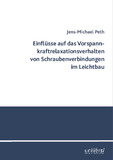Citation link:
http://dx.doi.org/10.25819/ubsi/10088Files in This Item:
| File | Description | Size | Format | |
|---|---|---|---|---|
| Dissertation_Peth_Jens_Michael.pdf | 15.53 MB | Adobe PDF |  View/Open |
| Dokument Type: | Doctoral Thesis | metadata.dc.title: | Einflüsse auf das Vorspannkraftrelaxationsverhalten von Schraubenverbindungen im Leichtbau | Other Titles: | Influences on preload relaxation behaviour of bolted joint connections in lightweight constructions | Authors: | Peth, Jens-Michael | Institute: | Fakultät IV - Naturwissenschaftlich-Technische Fakultät Institut für Konstruktion |
Free keywords: | Vorspannkraftrelaxation, Schraubenverbindungen, Leichtbau, Aluminium, Preload relaxation, Bolted joint connections, Lightweight design, Aluminum | Dewey Decimal Classification: | 620 Ingenieurwissenschaften und zugeordnete Tätigkeiten | GHBS-Clases: | XKD | Issue Date: | 2022 | Publish Date: | 2022 | Source: | Siegen: universi - Universitätsverlag Siegen. - ISBN 978-3-96182-119-8 | Abstract: | Zentrales Auslegungskriterium hochbeanspruchter Schraubenverbindungen (SV) ist die in der Verbindung vorherrschende Vorspannkraft. Diese nimmt im Laufe der Betriebszeit durch den Schädigungsmechanismus der Vorspannkraftrelaxation (VKR) ab, was zu einem Funktionsverlust der Verbindung führen kann. Durch Einsatz temperatursensitiver Leichtbaumaterialien wie Aluminium in Klemm- und Muttergewindekörpern nimmt die Gefahr der VKR insbesondere in Verbindung mit hoch ausgenutzten Stahlschrauben stark zu. Für derartige SV gibt es bisher weder Gestaltungshinweise zur Minimierung der VKR noch eine Möglichkeit der Abschätzung des zu erwartenden Vorspannkraftverlusts. Ziel dieser Arbeit ist daher die experimentelle Bestimmung der praxisrelevanten Einflussfaktoren auf das Vorspannkraftrelaxationsverhalten einer SV, bestehend aus einer Stahlschraube sowie Klemm- und Muttergewindekörpern aus Aluminium. Die zur Identifikation und Quantifizierung der Einflussfaktoren notwendigen experimentellen Reihenuntersuchungen werden mittelts taktiler Längenänderungsmessung an Modellverbindungen durchgeführt. Erstmalig wird bei ausgewählten Verbindungen die lokale Verformung des Klemmteils über ein im Rahmen dieser Arbeit entwickeltes optisch-mechanisches Verfahren gemessen, um eine ortsaufgelöste Relaxationsbetrachtung zu ermöglichen. In den Reihenuntersuchungen wurden die Einflussparameter Temperatur, Montagevorspannkraft, Klemmlänge, Außendurchmesser, Einschraubtiefe, Kontaktstellenrauheit sowie Werkstoff- und Legierungswahl von Schraube, Klemmteil und Muttergewindebauteil systematisch variiert. Den höchsten Einfluss auf die VKR haben Temperatur, Einschraubtiefe sowie Montagehöhe. Durch die Betrachtung der Vorspannkraftrelaxationsbeiträge zeigt sich, dass alle Teile der SV vorspannkraftmindernde Plastifizierungen aufweisen, wobei der Hauptteil auf das Klemmteil bzw. in Abhängigkeit der Einschraubtiefe vor allem auch auf das Muttergewindebauteil entfällt. Aus den gewonnenen Erkenntnissen wurden Gestaltungshinweise abgeleitet, die eine einfache und praxisrelevante Optimierung von temperaturbelasteten Schraubenverbindungen im Leichtbau ermöglichen. The central design criterion of a highly stressed bolted joint connection is its pre-load. Over the course of the operational lifetime of the connection this force is reduced by the damage mechanism of preload relaxation, which may lead to a loss of function of the connection. Using temperature sensitive materials like aluminium for clamped parts and nut thread parts considerably increases the risk of preload relaxation effects, especially if the steel bolts are highly utilized. Until now there is no design advice on how to reduce the preload relaxation nor a way to estimate the preload loss of such bolted joint connections. The aim of this work is the experimental determination of practice relevant factors which have an influence on preload relaxation behaviour. Most of the examined specimen use a screw made of steel, an aluminium clamped part, and an aluminium nut thread part. To determine and quantify the influencing factors on the preload relaxation behaviour a series of tests were carried out. The determination of preload is based on the bolt elongation, which was measured with a tactile sensor. Additionally, the local deformation of selected clamped parts was measured with a novel optical-mechanical measurement system to determine the local relaxation behaviour. The influence of the parameters temperature, assembly preload, clamping length, outer diameter of clamped part and nut thread part, thread engagement, surface roughness as well as the choice of material and alloy of screw, clamped part and nut thread part were systematically examined throughout the experiments. The parameters temperature, thread engagement and assembly preload have the highest influence on preload relaxation. The single contributions to the total preload loss show that all parts of the bolted joint connection have plastic material deformations, which results in a reduced preload. The main loss can be seen at the clamped part and, depending on the thread engagement, in the nut thread part. Design advice was derived from the experimental data to perform an easy and practically applicable optimization of thermally loaded bolted joint connections in lightweight constructions. |
DOI: | http://dx.doi.org/10.25819/ubsi/10088 | URN: | urn:nbn:de:hbz:467-21767 | URI: | https://dspace.ub.uni-siegen.de/handle/ubsi/2176 | License: | http://creativecommons.org/licenses/by-sa/4.0/ |
| Appears in Collections: | Universi Hochschulschriften |
This item is protected by original copyright |
Page view(s)
706
checked on Apr 3, 2025
Download(s)
2,595
checked on Apr 3, 2025
Google ScholarTM
Check
Altmetric
This item is licensed under a Creative Commons License


